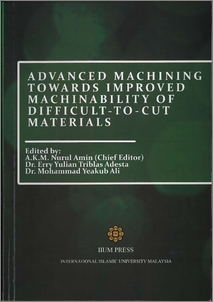Ishtiyaq, M. H. and Amin, A. K. M. Nurul and Patwari, Muhammed Anayet Ullah
(2011)
Application of response surface methodology coupled with genetic algorithm in the optimization of cutting conditions for surface roughness in end milling of Inconel 718 using coated WC-Co inserts.
In:
Advanced Machining Towards Improved Machinability of Difficult-to-Cut Materials.
IIUM Press, Kuala Lumpur, Malaysia, pp. 123-131.
ISBN 9789674181758
![[img]](http://irep.iium.edu.my/style/images/fileicons/application_pdf.png)  Preview |
|
PDF (Application of response surface methodology coupled with genetic algorithm in the optimization of cutting conditions for surface roughness in end milling of Inconel 718 using coated WC-Co inserts)
- Published Version
Download (554kB)
| Preview
|
Abstract
Process modeling and optimization are two important issues in today’s manufacturing. It is
important, in metal cutting, to select the machining parameters to ensure high quality of
machining products, reduce machining costs and increase machining efficiency. Nowadays
surface roughness and accuracy of product is getting greater attention in the industry. Surface
roughness and dimensional accuracy have important bearing on performances of any machined
part. Therefore, there is a need for predictions of these values. However number of surface
roughness prediction models available in the literature is limited [1-5]. B. Ozcelik et al [2]
generated 81 experimental data to develop a model by using Artificial Neural Networking
(ANN) for predicting the surface finish of Inconel 718 in End Milling and then used the
developed ANN model as a fitness function of GA to optimize the surface roughness. But the
development of surface roughness prediction model increases the total number of tests and as a
result the experimentation cost also increases.
Response Surface Methodology (RSM), as a group of mathematical and statistical techniques, is
useful for modeling the relationship between the input parameters (cutting conditions) and the
output variables. Many machining researchers have used response surface methodology to design
their experiments and assess results. Alauddin et al [3] applied response surface methodology to
predict the surface finish in end milling of Inconel 718 considering cutting speed and feed as
input parameters. S. Sharif et al [4] developed a predicted model for surface roughness when end
milling titanium alloy (Ti-6Al-4V) using uncoated carbide under flooded condition.
In the present work, an effort has been made to estimate the surface roughness values in end
milling of Inconel 718 using RSM. It has also been attempted to optimize the surface roughness
prediction model using a GA approach.
Actions (login required)
 |
View Item |


 Download Statistics
Download Statistics Download Statistics
Download Statistics